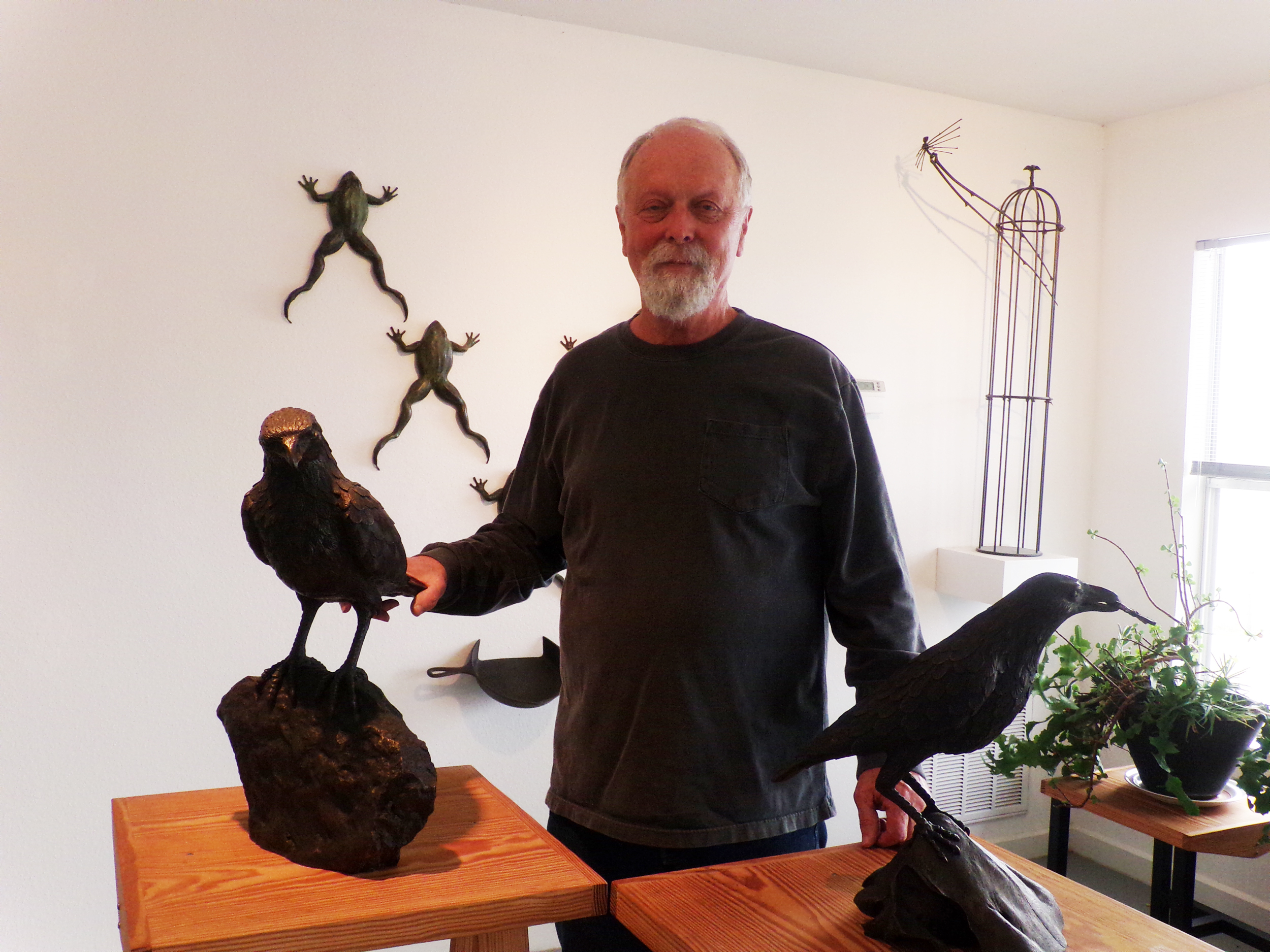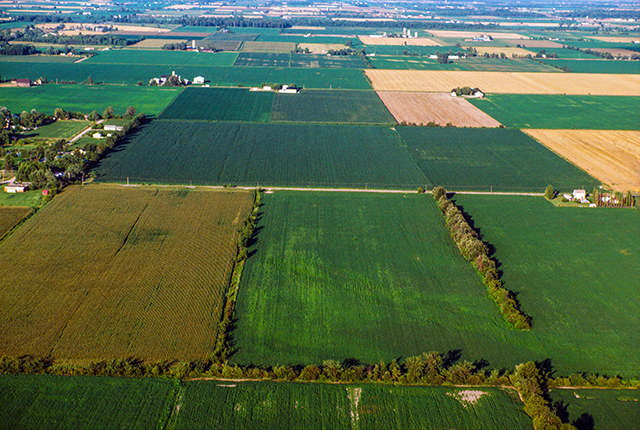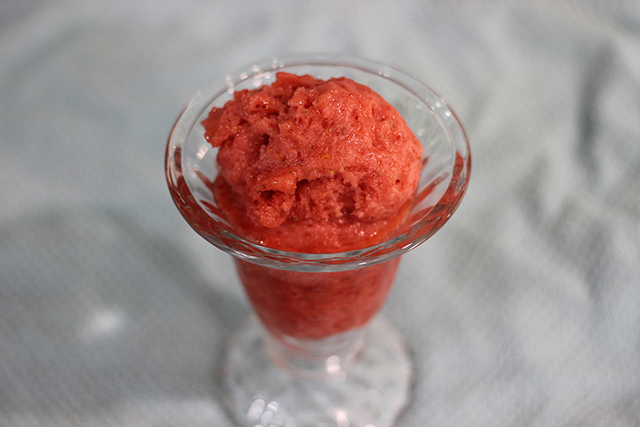Country Lifestyles
David Iles – Sculptor, Conservationist and the Man Behind the Scenes

By Judy Wade
Walking through Bolivar Bronze is like entering a combination of a fantasy land and the mad scientist’s laboratory.
In the foyer sit a beautiful bronze red tailed hawk and a crow. On one wall, frogs climb upward, and on another is a squirrel smoking a cigarette while nestled in the bib of a pair of overalls. Against the window is a wastebasket filled with miniature human skulls symbolizing wasted lives in Cambodia.
The first thing to catch your eye in the workroom is a life-size buck whose massive antlers are moss-crusted oak branches. A work in progress, his antlers will soon have colorful birds resting in them. As you look up, you see a miniature human skeleton dangling in front of a wall of various animal’s heads and horns.
In the foundry room itself, one huge vat and another smaller one wait to heat bronze or other metal to 1,500 to 1,800 degrees Fahrenheit to cast and bring to life some artist’s creation. Artists bring their creations in the clay or in the wax to be turned into bronze or some other metal. “From clay or wax to the finished sculpture is a long process,” the owner explained.
David Iles, who built the foundry in Bolivar in 2008, divides his time between casting for himself and others. He has one full time assistant, Martin Iles, and calls on fellow sculptor Vincent Villafranca from Alvord when he needs more help.
After receiving his Master of Fine Art in sculpting degree from the University of North Texas in Denton, Iles ran the sculpting lab there. Many of his pieces can be seen on the UNT campus. Eighteen of his bronze animals are poised around the Environmental Education, Science and Technology Building. “Eagle Relief” in the Legacy Room of the Alumni Center is a 15-foot-wide wall relief depicting an eagle flying back to its nest over a stainless steel image of the UNT campus. Used as a fund raiser for scholarships, donors can purchase a leaf for $500 or a branch for $1,000. Iles’ most recent piece at UNT is called “Flight of the Eagle” and can be seen in the Diamond Eagle Suite.
To read more pick up a copy of the April 2017 NTFR issue. To subscribe call 940-872-5922.
Country Lifestyles
While We Were Sleeping

By Martha Crump
That old adage, “What you don’t know won’t hurt you.,” may have some basis in truth when applied to minor situations. However, when what you don’t know is presented in the form of a “Trojan Horse” and is what amounts to an incredible attempt to fleece American property rights, it becomes a different story altogether.
To put this unbelievable tale together, we need to step back to Joe Biden’s 2021 Executive Order which pledged commitment to help restore balance on public lands and waters, to create jobs, and to provide a path to align the management of America’s public lands and waters with our nation’s climate, conservation, and clean energy goals.
To read more, pick up a copy of the April issue of NTFR magazine. To subscribe by mail, call 940-872-5922.
Country Lifestyles
Lacey’s Pantry: Strawberry Sorbet

By Lacey Vilhauer
Ingredients:
1 whole lemon, seeded and roughly chopped
2 cups sugar
2 pounds strawberries, hulled
Juice of 1 to 2 lemons
¼ cup water
Directions:
Place the chopped lemon and sugar in a food processor and pulse until combined. Transfer to a large bowl. Puree the strawberries in a food processor and add to the lemon mixture along with juice of one lemon and water. Taste and add more juice as desired.
To read more, pick up a copy of the April issue of NTFR magazine. To subscribe by mail, call 940-872-5922.
Country Lifestyles
A Mountain Out of a Molehill

By Nicholas Waters
As winter plods along – come Spring and gopher mounds – homeowners and farmers find themselves playing a familiar song – fiddling while Rome is burning.
Let’s make a mountain out of a molehill. Those mounds on your lawn and pasture could be moles, but they’re more than likely gophers; Plains Pocket Gophers to be pragmatic – Geomys bursarius to be scientific.
These rodents dig and chew, and the damage they can do goes beyond the mounds we mow over. Iowa State University cited a study in Nebraska showing a 35 percent loss in irrigated alfalfa fields due to the presence of pocket gophers; the number jumped to 46 percent in decreased production of non-irrigated alfalfa fields.
The internet is replete with academic research from coast-to-coast on how to curtail gopher populations, or at least control them. Kansas State University – then called Kansas State Agricultural College – also published a book [Bulletin 152] in February 1908 focused exclusively on the pocket gopher.
To read more, pick up a copy of the April issue of NTFR magazine. To subscribe by mail, call 940-872-5922.
-

 Country Lifestyles1 year ago
Country Lifestyles1 year agoScott & Stacey Schumacher: A Growth Mindset
-

 Equine7 months ago
Equine7 months agoThe Will to Win
-

 Country Lifestyles7 years ago
Country Lifestyles7 years agoStyle Your Profile – What your style cowboy hat says about you and new trends in 2017
-

 Country Lifestyles4 years ago
Country Lifestyles4 years agoAmber Crawford, Breakaway Roper
-

 HOME7 years ago
HOME7 years agoGrazing North Texas – Wilman Lovegrass
-

 Country Lifestyles7 years ago
Country Lifestyles7 years agoDecember 2016 Profile, Rusty Riddle – The Riddle Way
-

 Country Lifestyles8 years ago
Country Lifestyles8 years agoJune 2016 Profile – The man behind the mic: Bob Tallman
-

 Outdoor9 years ago
Outdoor9 years agoButtercup or Primrose?






